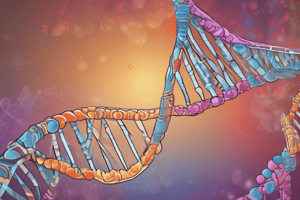Podcast
Questions and Answers
Which DNA repair mechanism is responsible for removing and replacing damaged bases?
Which DNA repair mechanism is responsible for removing and replacing damaged bases?
- Homologous Recombination
- Nonhomologous End Joining
- Mismatch Repair
- Base Excision Repair (correct)
What does the enzyme DNA glycosylase recognize and remove in the Base Excision Repair pathway?
What does the enzyme DNA glycosylase recognize and remove in the Base Excision Repair pathway?
- Uracil (correct)
- Thymine
- Adenine
- Cytosine
In Base Excision Repair, what is the function of AP endonuclease?
In Base Excision Repair, what is the function of AP endonuclease?
- Ligation
- Recognizing and removing damaged bases
- Cleaving the gap in the DNA (correct)
- Filling the gap
Which type of repair uses a matching DNA sequence as a template for repair?
Which type of repair uses a matching DNA sequence as a template for repair?
In Homologous Recombination, what is primarily used for repair?
In Homologous Recombination, what is primarily used for repair?
What enzyme fills the remaining gap in Base Excision Repair?
What enzyme fills the remaining gap in Base Excision Repair?
Flashcards are hidden until you start studying
Study Notes
DNA Repair Types and Mechanisms
- Multiple DNA repair pathways exist, including Base Excision Repair (BER), Homologous Recombination (HR), and Nonhomologous End Joining (NHEJ)
Base Excision Repair (BER)
- Removes and replaces damaged bases in DNA
- Consists of short patch repair and long patch repair mechanisms
- Short patch repair:
- Basic site is processed and filled by specific enzymes
- Long patch repair:
- Gaps are tailored and DNA synthesis occurs, followed by ligation
- Example of BER: repair of uracil-containing DNA
- DNA glycosylase recognizes and removes uracil base, creating an AP site
- AP endonuclease cleaves the gap
- Remaining sugar is removed, and gap is filled using DNA polymerase and sealed with ligase
Homologous Recombination (HR)
- Precise repair pathway requiring a matching DNA sequence as a template
- Primarily uses sister chromatid (a copy of the damaged DNA) for repair
BER Pathway Outline
- DNA glycosylase:
- Recognizes and removes uracil base, creating an AP site
- AP endonuclease (possibly with phosphodiesterase):
- Cleaves the gap
- DNA polymerase + DNA ligase:
- Fills the gap and seals the DNA strand
Studying That Suits You
Use AI to generate personalized quizzes and flashcards to suit your learning preferences.



